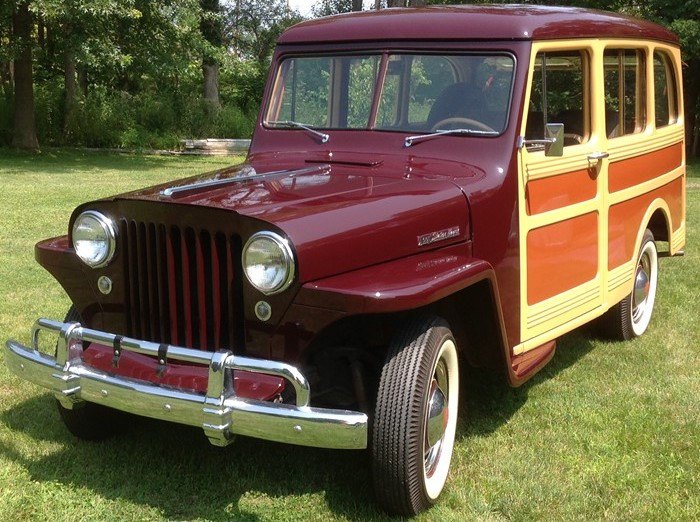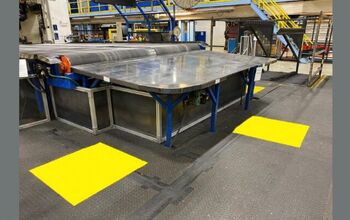Rare Rides: The 1948 Willys-Overland Station Wagon - the First SUV?

Rare Rides has featured a classic Jeep previously, with the Kaiser-Jeep-produced Jeepster Commando. While that model was eventually succeeded by the Jeep Cherokee, today’s Rare Ride was predecessor to the Wagoneer.
Let’s learn about a seven-seat SUV from 1948: the Willys Overland Station Wagon.
The Station Wagon was a new type of car for Willys, which found itself operating in a different consumer landscape after the conclusion of World War II. At the time, companies that built car bodies had their hands full with incredible pent up demand. Unfortunately, Willys did not manufacture its own car bodies — and it was relatively low on cash, as well.
Industrial designer Brooks Stevens took all those factors into account when he designed the all-new Jeep family wagon. And he proposed an innovative construction method, too. Using his prior knowledge in the design and production of household appliances, Stevens drew up a wagon body made entirely of steel. The panels were easy to produce by sheet metal companies, and could be built at much lower cost and complexity than typical car bodies.
The all-steel wagon body was a new idea; prior station wagon bodies consisted primarily of wood. Wood bodies were heavier, more complicated to produce, not as sturdy, and required more maintenance than steel. A nod to the tastes of consumers, many Station Wagons were painted to look vaguely as though the body had wood panels.
Other notable advancements included an independent front suspension, a first for Willys. Lead engineer at Willys, Barney Roos, created a transverse leaf spring suspension setup called Planadyne. It was similar in concept to the design Roos created when he worked at Studebaker a decade prior.
At introduction, the only engine available in the Station Wagon was the 2.2-liter inline-four. Nicknamed Go Devil, it produced 105 torques and 60 horsepower. More powerful, larger engines arrived in 1950, 1952, and 1962.
The new Station Wagon entered production in 1946. A subsequent panel van version quickly followed, and the line was expanded by the more luxurious Station Sedan in 1948. Optional four-wheel drive was added to the line in 1949. It was a first for a family-hauling wagon, and a move which many argue created the first-ever SUV.
The Station Wagon remained in production though 1964 in the US, 1970 in Argentina, and 1977 in Brazil. In the U.S. it served its purpose of putting Kaiser Jeep on the map as a provider of off-road family vehicles. Pleased with the initial work, Jeep hired Brooks Stevens to create the Station Wagon’s successor. Introduced for model year 1963, it would become an icon: Wagoneer.
Today’s Rare Ride is for sale in Ohio. It’s been meticulously maintained over the years, and appears to have most of its original trim and interior intact. Notable is the presence of a novel third-row seat — an option not often selected in the Forties. Ask is $37,950.
[Images: seller]

Interested in lots of cars and their various historical contexts. Started writing articles for TTAC in late 2016, when my first posts were QOTDs. From there I started a few new series like Rare Rides, Buy/Drive/Burn, Abandoned History, and most recently Rare Rides Icons. Operating from a home base in Cincinnati, Ohio, a relative auto journalist dead zone. Many of my articles are prompted by something I'll see on social media that sparks my interest and causes me to research. Finding articles and information from the early days of the internet and beyond that covers the little details lost to time: trim packages, color and wheel choices, interior fabrics. Beyond those, I'm fascinated by automotive industry experiments, both failures and successes. Lately I've taken an interest in AI, and generating "what if" type images for car models long dead. Reincarnating a modern Toyota Paseo, Lincoln Mark IX, or Isuzu Trooper through a text prompt is fun. Fun to post them on Twitter too, and watch people overreact. To that end, the social media I use most is Twitter, @CoreyLewis86. I also contribute pieces for Forbes Wheels and Forbes Home.
More by Corey Lewis
Latest Car Reviews
Read moreLatest Product Reviews
Read moreRecent Comments
- Jalop1991 In a manner similar to PHEV being the correct answer, I declare RPVs to be the correct answer here.We're doing it with certain aircraft; why not with cars on the ground, using hardware and tools like Telsa's "FSD" or GM's "SuperCruise" as the base?Take the local Uber driver out of the car, and put him in a professional centralized environment from where he drives me around. The system and the individual car can have awareness as well as gates, but he's responsible for the driving.Put the tech into my car, and let me buy it as needed. I need someone else to drive me home; hit the button and voila, I've hired a driver for the moment. I don't want to drive 11 hours to my vacation spot; hire the remote pilot for that. When I get there, I have my car and he's still at his normal location, piloting cars for other people.The system would allow for driver rest period, like what's required for truckers, so I might end up with multiple people driving me to the coast. I don't care. And they don't have to be physically with me, therefore they can be way cheaper.Charge taxi-type per-mile rates. For long drives, offer per-trip rates. Offer subscriptions, including miles/hours. Whatever.(And for grins, dress the remote pilots all as Johnnie.)Start this out with big rigs. Take the trucker away from the long haul driving, and let him be there for emergencies and the short haul parts of the trip.And in a manner similar to PHEVs being discredited, I fully expect to be razzed for this brilliant idea (not unlike how Alan Kay wasn't recognized until many many years later for his Dynabook vision).
- B-BodyBuick84 Not afraid of AV's as I highly doubt they will ever be %100 viable for our roads. Stop-and-go downtown city or rush hour highway traffic? I can see that, but otherwise there's simply too many variables. Bad weather conditions, faded road lines or markings, reflective surfaces with glare, etc. There's also the issue of cultural norms. About a decade ago there was actually an online test called 'The Morality Machine' one could do online where you were in control of an AV and choose what action to take when a crash was inevitable. I think something like 2.5 million people across the world participated? For example, do you hit and most likely kill the elderly couple strolling across the crosswalk or crash the vehicle into a cement barrier and almost certainly cause the death of the vehicle occupants? What if it's a parent and child? In N. America 98% of people choose to hit the elderly couple and save themselves while in Asia, the exact opposite happened where 98% choose to hit the parent and child. Why? Cultural differences. Asia puts a lot of emphasis on respecting their elderly while N. America has a culture of 'save/ protect the children'. Are these AV's going to respect that culture? Is a VW Jetta or Buick Envision AV going to have different programming depending on whether it's sold in Canada or Taiwan? how's that going to effect legislation and legal battles when a crash inevitibly does happen? These are the true barriers to mass AV adoption, and in the 10 years since that test came out, there has been zero answers or progress on this matter. So no, I'm not afraid of AV's simply because with the exception of a few specific situations, most avenues are going to prove to be a dead-end for automakers.
- Mike Bradley Autonomous cars were developed in Silicon Valley. For new products there, the standard business plan is to put a barely-functioning product on the market right away and wait for the early-adopter customers to find the flaws. That's exactly what's happened. Detroit's plan is pretty much the opposite, but Detroit isn't developing this product. That's why dealers, for instance, haven't been trained in the cars.
- Dartman https://apnews.com/article/artificial-intelligence-fighter-jets-air-force-6a1100c96a73ca9b7f41cbd6a2753fdaAutonomous/Ai is here now. The question is implementation and acceptance.
- FreedMike If Dodge were smart - and I don't think they are - they'd spend their money refreshing and reworking the Durango (which I think is entering model year 3,221), versus going down the same "stuff 'em full of motor and give 'em cool new paint options" path. That's the approach they used with the Charger and Challenger, and both those models are dead. The Durango is still a strong product in a strong market; why not keep it fresher?







































Comments
Join the conversation
1921 Livingood Model-T https://www.fourwheeler.com/project-vehicles/129-0510-1921-ford-model-t-4x4/
This truck is beautiful . I worked for Milne Bros. Jeep in 197.....?7? and we were still able to get everything used on these old work horses, even the machined brass bushings used in the front A-Frames . The new cartridge typ oil filters were still being made by the same old company and still had "Willys overland" printed on the actual filter . In the 1960's in New Hampshire we had the battered remains of a 1940 Dodge with this same typ of body . I wonder if it's still there rusting away off the edge of an abandoned hay field . -Nate